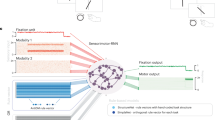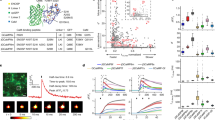Abstract
The spiking of neuronal populations in motor cortex provides accurate information about movement parameters. Here we show that hand movement target and velocity can be inferred from multiple local field potentials (LFPs) in single trials approximately as efficiently as from multiple single-unit activity (SUA) recorded from the same electrodes. Our results indicate that LFPs can be used as an additional signal for decoding brain activity, particularly for new neuroprosthetic applications.
This is a preview of subscription content, access via your institution
Access options
Subscribe to this journal
Receive 12 print issues and online access
$209.00 per year
only $17.42 per issue
Buy this article
- Purchase on Springer Link
- Instant access to full article PDF
Prices may be subject to local taxes which are calculated during checkout



Similar content being viewed by others
References
Donchin, O. et al. Exp. Brain. Res. 140, 45–55 (2001).
Cardoso de Oliveira, S., Gribova, A., Donchin, O., Bergman, H. & Vaadia, E. Eur. J. Neurosci. 14, 1881–1896 (2001).
Sanes, J.N. & Donoghue, J.P. Proc. Natl. Acad. Sci. USA 90, 4470–4474 (1993).
Murthy, V.N. & Fetz, E.E. J. Neurophysiol. 76, 3949–3967 (1996).
Baker, S.N., Killner, J.M., Pinches, E.M. & Lemon, R.N. Exp. Brain Res. 128, 109–117 (1999).
Donchin, O., Gribova, A., Steinberg, O., Bergman, H. & Vaadia, E. Nature 395, 274–278 (1998).
Wessberg, J. et al. Nature 408, 361–365 (2000).
Taylor, D.M., Tillery, S.I. & Schwartz, A.B. Science 296, 1829–1832 (2002).
Serruya, M.D., Hatsopoulos, N.G., Paninski, L., Fellows, M.R. & Donoghue, J.P. Nature 416, 141–142 (2002).
Pesaran, B., Pezaris, J.S., Sahani, M., Mitra, P.P. & Andersen, R.A. Nat. Neurosci. 5, 805–811 (2002).
Acknowledgements
This study was supported by the Boehringer Ingelheim Fonds (BIF), the German-Israeli Foundation for Scientific Research and Development (GIF), the German Bundesministerium für Bildung und Forschung (BMBF-DIP), the WIN-Kolleg of the Heidelberg Academy of Sciences and Humanities (Germany), the Deutsche Forschungsgemeinschaft (DFG, CA 245) and the ISF center of excellence grant (8006/00).
Author information
Authors and Affiliations
Corresponding author
Ethics declarations
Competing interests
The authors declare no competing financial interests.
Supplementary information
Supplementary Fig. 1.
Temporal evolution of tuning strength. Colors depict the different types of signals: LFPs (green), SUAs which were checked for stability (red) and MUAs (blue). Tuning strength was calculated as the signal-to-noise ratio of the tuning curves in windows of 50 ms width from the unsmoothed signals. (JPG 14 kb)
Supplementary Fig. 2.
Decoding power and accuracy of trajectory prediction for different algorithms. We used the neuronal signals (LFP, SUA, MUA) that were recorded simultaneously by eight electrodes. The graphs depict averages over 10 recording sessions and both, left- and right-handed movements. In (a), (b) and (c) results are shown for the whole recording set of single-units. Subfigure (b) includes results for SUAs additionally checked for stability across trials. (a) Decoding power for different classification algorithms: PLDA, SVM with radial basis function kernel, SVM with linear kernel, multivariate Gaussian model, population vector approach (from left to right). Error bars depict the standard deviation. (b) Decoding power as a function of the width of the smoothing kernel. Colors and line styles as in Fig. 3a. (c) Accuracy of 2D trajectory prediction (average correlation coefficients across sessions and handedness) using either SVM regression (SVM) or the linear filter (LF). (JPG 10 kb)
Supplementary Fig. 3.
Decoding power of individual single-units taken from the whole recording set regardless of stability. (a) Distribution of decoding power for individual SUA, shown for contralateral (left) and ipsilateral (right) movements. Dotted lines depict the chance level (0.125). (b) Contra- and ipsilateral decoding power was largely uncorrelated. (JPG 15 kb)
Rights and permissions
About this article
Cite this article
Mehring, C., Rickert, J., Vaadia, E. et al. Inference of hand movements from local field potentials in monkey motor cortex. Nat Neurosci 6, 1253–1254 (2003). https://doi.org/10.1038/nn1158
Received:
Accepted:
Published:
Issue Date:
DOI: https://doi.org/10.1038/nn1158
This article is cited by
-
High-resolution neural recordings improve the accuracy of speech decoding
Nature Communications (2023)
-
Functional cortical localization of tongue movements using corticokinematic coherence with a deep learning-assisted motion capture system
Scientific Reports (2022)
-
The significance of neural inter-frequency power correlations
Scientific Reports (2021)
-
Multiscale low-dimensional motor cortical state dynamics predict naturalistic reach-and-grasp behavior
Nature Communications (2021)
-
Single-Trial Decoding from Local Field Potential Using Bag of Word Representation
Brain Topography (2020)



